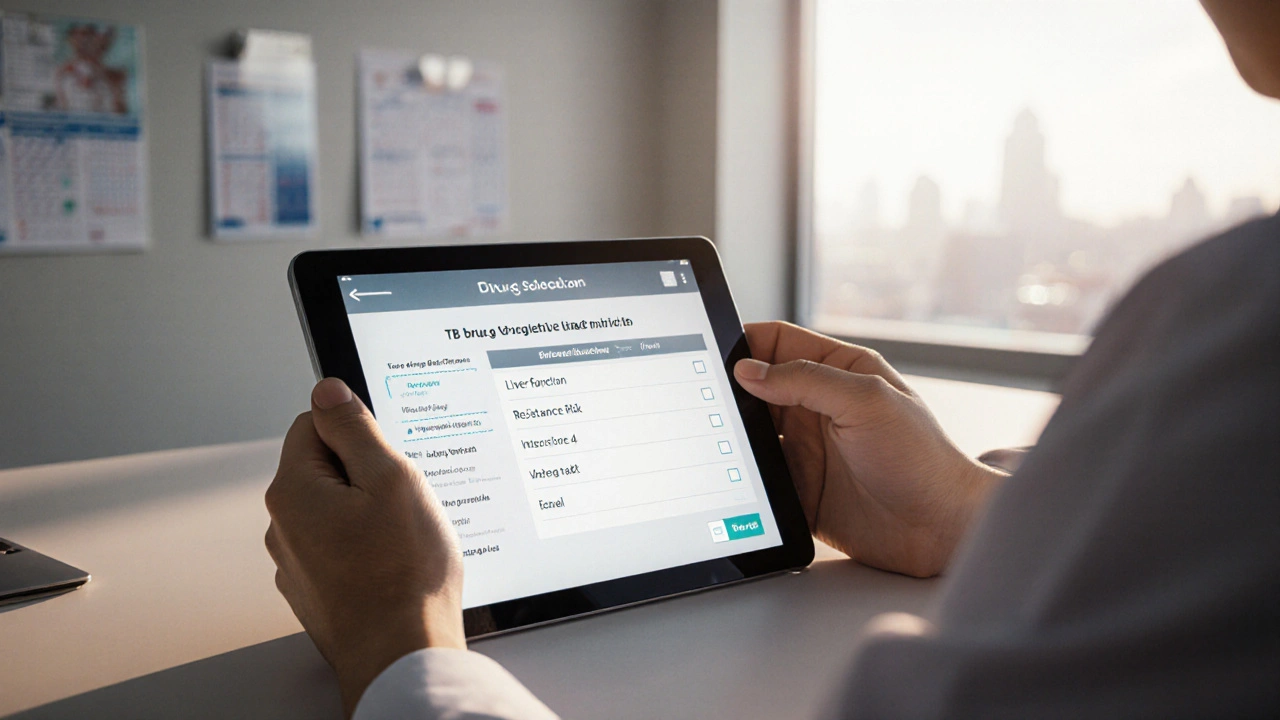TB Drug Selection Guide
Enter your patient's clinical factors and click "Determine Recommended Regimen" to get personalized treatment guidance.
TL;DR
- isoniazid remains the backbone of standard TB therapy but can cause liver toxicity.
- Rifampin offers strong bactericidal activity and is key in shortened regimens.
- Ethambutol adds safety against resistance, especially when susceptibility is unknown.
- Pyrazinamide accelerates bacterial kill in acidic environments, crucial for the intensive phase.
- Fluoroquinolones (e.g., levofloxacin) are valuable for drug‑resistant or intolerant patients.
Every year, tuberculosis (TB) claims more than 1.5million lives worldwide. While the classic 6‑month regimen (isoniazid, rifampin, ethambutol, pyrazinamide) works for most, clinicians often need to tweak it because of side‑effects, resistance patterns, or patient‑specific factors. This guide breaks down isoniazid, compares it with the most common alternatives, and helps you decide which drug fits each clinical scenario.
What is Isoniazid?
Isoniazid is a first‑line antitubercular medication that inhibits mycolic acid synthesis in Mycobacterium tuberculosis. Introduced in the 1950s, it quickly became the cornerstone of TB treatment thanks to its low cost and high potency against actively replicating bacteria. Typical dosing for adults is 5mg/kg (max 300mg) once daily, administered for six to nine months depending on the regimen. Its main drawback is hepatotoxicity-up to 10% of patients develop elevated liver enzymes, and a smaller fraction experience severe hepatitis.
Key Alternatives to Isoniazid
Rifampin
Rifampin is a broad‑spectrum antibiotic that targets the bacterial RNA polymerase, halting transcription. It’s highly bactericidal and can shorten treatment duration when combined with other drugs. Standard adult dose: 10mg/kg (max 600mg) once daily. Major side‑effects include orange‑colored bodily fluids and drug‑enzyme interactions, especially with anticoagulants and antiretrovirals.
Ethambutol
Ethambutol blocks arabinosyl transferase, disrupting cell‑wall synthesis. It’s primarily used to prevent the emergence of resistance when the susceptibility of the Mycobacterium strain is unknown. Dose: 15-25mg/kg once daily. Visual acuity loss (optic neuritis) is the most concerning adverse event, typically reversible if detected early.
Pyrazinamide
Pyrazinamide is a pro‑drug that becomes active in acidic environments-exactly where dormant TB bacilli hide. It’s essential for the intensive phase (first 2months) to achieve rapid bacterial kill. Adult dosing: 20-25mg/kg once daily. It can cause hyperuricemia and hepatotoxicity, often synergistic with isoniazid’s liver effects.
Fluoroquinolones (Levofloxacin)
Levofloxacin belongs to the fluoroquinolone class, inhibiting DNA gyrase and topoisomeraseIV. It’s reserved for multidrug‑resistant TB (MDR‑TB) or when patients cannot tolerate first‑line agents. Typical dose: 750mg once daily. Side‑effects include tendonitis, QT prolongation, and central nervous system disturbances.

Comparative Overview
| Drug | Mechanism | Typical Dose (Adult) | Efficacy (Intensive Phase) | Major Toxicities | Role in Regimen |
|---|---|---|---|---|---|
| Isoniazid | Inhibits mycolic acid synthesis | 5mg/kg daily (max300mg) | High; essential for continuation phase | Hepatotoxicity, peripheral neuropathy | Backbone of standard 6‑month regimen |
| Rifampin | Inhibits RNA polymerase | 10mg/kg daily (max600mg) | Very high; can shorten therapy | Hepatotoxicity, orange secretions, drug‑interactions | Key bactericidal agent, often paired with isoniazid |
| Ethambutol | Blocks arabinosyl transferase | 15-25mg/kg daily | Moderate; mainly protective | Optic neuritis, rash | Added when susceptibility unknown |
| Pyrazinamide | Pro‑drug active in acidic pH | 20-25mg/kg daily | High; essential for rapid kill | Hepatotoxicity, hyperuricemia | Intensive‑phase only (first 2months) |
| Levofloxacin | Inhibits DNA gyrase & topoisomeraseIV | 750mg daily | Variable; useful against resistant strains | Tendonitis, QT prolongation, CNS effects | Second‑line for MDR‑TB or intolerance |
Choosing the Right Regimen for Different Patients
When deciding whether to keep isoniazid or substitute it, consider three major axes: liver health, resistance risk, and drug‑interaction profile.
- Liver‑Compromised Patients: If baseline transaminases are >2× upper limit, start with rifampin‑ethambutol‑pyrazinamide and reserve isoniazid for the continuation phase only if liver tests improve.
- High Resistance Settings: In regions where isoniazid resistance exceeds 10%, begin with rifampin, ethambutol, pyrazinamide, and add a fluoroquinolone; tailor based on susceptibility testing.
- Drug‑Interaction Concerns: Patients on antiretrovirals (especially protease inhibitors) or warfarin may need to avoid rifampin; in such cases, levofloxacin can replace rifampin while retaining bactericidal activity.
Real‑world example: A 45‑year‑old man with newly diagnosed pulmonary TB and mild hepatitis (ALT 1.8× ULN) was started on a regimen of rifampin, ethambutol, and pyrazinamide. Isoniazid was re‑introduced after four weeks when liver enzymes normalized, completing a standard six‑month course without further liver issues.
Practical Checklist for Clinicians
- Confirm TB diagnosis with sputum smear, culture, or GeneXpert.
- Order baseline liver function tests (ALT, AST, bilirubin) and visual acuity screening.
- Review patient medication list for rifampin‑inducing agents.
- Select first‑line regimen (HRZE) if no contraindications.
- If any contraindication exists, substitute according to the table above.
- Monitor liver enzymes at weeks2,4, and monthly thereafter.
- Re‑assess visual acuity at month2 if ethambutol is used.
- Adjust regimen based on susceptibility results (especially for isoniazid‑resistant isolates).
Frequently Asked Questions
Can I replace isoniazid with another drug in a standard regimen?
Yes. In cases of isoniazid intolerance or resistance, clinicians often swap it for a fluoroquinolone (e.g., levofloxacin) or extend the duration of rifampin‑ethambutol‑pyrazinamide. However, the replacement should be guided by susceptibility testing and the patient’s overall risk profile.
Why is pyrazinamide only used in the first two months?
Pyrazinamide works best in acidic environments typical of early lesions. After the bacterial load drops, its added benefit wanes, while its hepatotoxic risk persists. Therefore, guidelines limit its use to the intensive phase.
What monitoring is required for ethambutol?
Baseline visual acuity and color vision testing are essential. Repeat the exam monthly; any drop in acuity >2 lines or new color‑vision deficit warrants drug discontinuation.
Is rifampin safe for pregnant women?
Rifampin is classified as Category C but is widely used in pregnancy because benefits outweigh risks. Liver function should still be monitored closely.
When should a fluoroquinolone be considered first‑line?
Only when isoniazid resistance is confirmed or when a patient cannot tolerate two or more first‑line agents. In such scenarios, levofloxacin combined with rifampin and pyrazinamide can achieve cure rates comparable to standard therapy.
Understanding how isoniazid stacks up against its alternatives empowers clinicians to tailor TB treatment, minimize toxicity, and combat drug resistance. By applying the checklist above, you’ll be ready to make evidence‑based choices for every patient scenario.



12 Comments
Kristen Holcomb
October 2, 2025 AT 21:31Great rundown on when to swap out isoniazid. If a patient has even mildly elevated LFTs, I usually start with rifampin, ethambutol, and pyrazinamide and keep an eye on the enzymes. Once the labs improve, you can safely bring back isoniazid for the continuation phase. Also, don’t forget to give pyridoxine to prevent peripheral neuropathy-easy fix! Lastly, always re‑check visual acuity if ethambutol is on board.
justin davis
October 9, 2025 AT 20:11Wow-so many drug choices!!! You could write a novel on this, but the TL;DR is: stick with HRZE unless the liver screams, the bug resists, or the meds clash. Then swap wisely. Cheers!
David Lance Saxon Jr.
October 16, 2025 AT 18:51From a pharmacodynamic perspective, the decision matrix for isoniazid substitution transcends mere hepatotoxicity thresholds; it embodies the ontological interplay between bacterial replication fidelity and host metabolic capacity. When hepatic cytochrome P450 isoforms are saturated, the resultant accumulation of reactive metabolites precipitates a cascade of oxidative stress, thereby amplifying the risk of fulminant hepatitis. Consequently, clinicians must integrate quantitative liver function indices-ALT, AST, bilirubin-with qualitative assessments of patient comorbidities, such as HIV co‑infection or alcohol use disorder. Moreover, resistance epidemiology, quantified by regional prevalence percentages, informs whether a fluoroquinolone adjunct is warranted to circumvent isoniazid‑resistant bacilli. Drug‑drug interaction potential, especially with antiretroviral agents, necessitates a meticulous review of enzyme induction profiles; rifampin, a potent inducer, can diminish plasma concentrations of protease inhibitors, undermining virologic suppression. In scenarios where rifampin cannot be employed, levofloxacin serves as a viable alternative, albeit with its own spectrum of adverse events-including tendonopathy and QT prolongation-that demand vigilant cardiac monitoring. The therapeutic algorithm thus becomes a multidimensional lattice, balancing bactericidal potency, toxicity mitigation, and resistance containment. Empirical data suggest that initiating therapy with a rifampin‑ethambutol‑pyrazinamide backbone, while deferring isoniazid until hepatic parameters normalize, yields comparable cure rates to the classic HRZE regimen. Nonetheless, longitudinal studies reveal that delayed isoniazid introduction may modestly extend time to sputum conversion, a factor worth considering in highly infectious patients. Ultimately, the clinician's gestalt-shaped by experience, patient preferences, and health system resources-determines the optimal regimen, underscoring the art inherent in antimicrobial stewardship.
Moore Lauren
October 23, 2025 AT 17:31Quick tip: give pyridoxine with isoniazid to prevent neuropathy. If liver enzymes jump, pause isoniazid, monitor, then re‑add. Visual checks for ethambutol are a must.
Jonathan Seanston
October 30, 2025 AT 15:11Friendly reminder-always double‑check the patient’s medication list before starting rifampin. Even over‑the‑counter meds can cause big interactions.
Sukanya Borborah
November 6, 2025 AT 13:51Honestly, this guide feels like a textbook rewrite. The hepatotoxicity risk of isoniazid is over‑emphasized; most patients tolerate it fine. Also, the fluoroquinolone swap is rarely needed outside MDR‑TB. Just keep the basics and don’t obsess over every lab value.
bruce hain
November 13, 2025 AT 12:31The presented regimen aligns with WHO standards; deviation should be justified by robust susceptibility data.
Stu Davies
November 20, 2025 AT 11:11Thanks for the clear table! 😊 It really helped me explain the plan to my patient today. The visual check reminder was especially useful.
Nadia Stallaert
November 27, 2025 AT 09:51Okay, so picture this!!! A patient walks into the clinic with a cough that just won’t quit, the labs are flashing red like a Christmas tree, the doctor says, “We’ll go with isoniazid, but watch the liver!”-and then the liver decides to throw a party of its own!!! Meanwhile, the pharmacist is yelling about drug interactions, the nurse is checking vision every other minute, and somewhere a fluoroquinolone is sulking in the corner waiting for its moment to shine!!! In short, the whole process is a circus, but the safety nets are there if you actually pay attention!!!
Greg RipKid
December 4, 2025 AT 08:31Totally agree-monitoring is key.
John Price Hannah
December 11, 2025 AT 07:11Well, if we’re going to criticize the guide, let’s note that the over‑reliance on fluoroquinolones fuels resistance trends. Every time we swap in levofloxacin without solid susceptibility data, we’re basically handing the bacteria a cheat code. Also, the tone of the “TL;DR” section feels a bit dismissive of the complexities clinicians face daily. Lastly, the visual acuity reminders are essential, but they should be emphasized more than a bullet point buried in a list. In short, the guide is useful but could be more nuanced.
Echo Rosales
December 18, 2025 AT 05:51I’d argue the standard HRZE regimen is overrated; local resistance patterns matter more than textbook protocols.